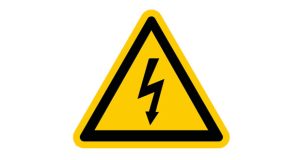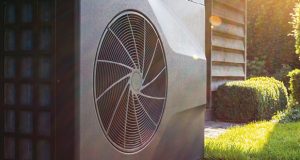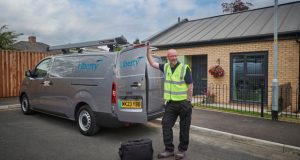Paul Langford, Engineering Director, Colt International expounds on the benefits of evaporative cooling
Evaporative cooling is an exceptionally efficient and cost-effective means of cooling industrial buildings, production facilities, warehouses and data centres. It is highly effective in all weather conditions and its cooling effect is highest when the outside temperature is hotter – precisely when it is most needed. It also provides 100 per cent fresh air, maintaining good air quality inside the building. When temperature and air quality are an issue in a large industrial building, housing processes that generate high levels of heat and toxic emissions, a well-designed evaporative cooling system can be the perfect solution.
External air is cooled through water evaporation in a two-step process
The Primary Process: As the airflow passes over the water, water evaporates into the air. The heat energy necessary for the evaporation is withdrawn from the air. The sensible air temperature decreases continuously. The evaporated humidity absorbed by the air is also referred to as “latent heat”.
The Secondary Process: As the evaporative cooler cools down the air, the secondary phase is to remove the latent heat from the building. The temperature in the building falls as a result of the heat dissipation in the desired manner. In general, the hotter the weather, the more efficient the cooler is. This means the Evaporative Cooling adapts to the outside temperature, and cools the internal environment accordingly.
What are the health benefits that evaporative cooling offers your staff?
Evaporative cooling systems can help you ensure that the air your staff breathe inside your buildings is actually cleaner than the air outside of it.
Traditional air conditioning systems re-circulate air around a building, which means bacteria, pollen, dust and all manner of other harmful or irritating particles are continuously inhaled by staff. As evaporative coolers work by continuously pulling outside air into the building and then pushing it out again, these systems only use the air once. This means fresher air all day for your staff.
A series of tests carried out for Colt as part of the VDI 6022 certification, have confirmed that installing Colt CoolStream systems reduced the concentration levels of the harmful Cladosporium bacteria in the air (known to cause infections with skin, sinuses and lungs). Levels of the bacteria in the air were found to be more than 97.7 per cent lower after passing through CoolStream. Large concentrations of this bacteria can also negatively affect asthmatics and people suffering from respiratory diseases.
In addition, the concentration of Aspergillus fumigatus in the air, which is linked to chronic pulmonary infections in immunosuppressed individuals, was found to be 85 per cent lower in the ‘cleaned’ air supplied by CoolStream.
In total, eight different groups of bacteria genus were tested and all were reported as showing reductions in concentrations in the air of harmful bacteria – some levels were reduced so much that it was below measurable limits. So in effect, the air supplied to the building will be cleaner than the fresh outside air.
Evaporative Cooling offers integrated filtration within the unit allowing for the highly effective removal of dust, another respiratory concern. Standard filter modules complying to ISO 16890 up to ePM1 are available with automatic contamination monitoring.
Also, unlike traditional air-conditioning which often results in low humidity air, the use of Evaporative Cooling to cool the workplace avoids symptoms associated with dry skin and eyes. Because the temperature of the air supplied is not as low as refrigerated based systems there isn’t the same risk of dry air and uncomfortable draughts.
How do I know Evaporative Cooling is safe?
One question that often comes up when discussing a water based cooling system, such as evaporative cooling, is always about its safety and in particular about the control of legionella bacteria.
Legionella is transmitted through inhalation of aerosol droplets containing the bacteria, and there are two key risk areas that water based systems need to address:
- Waterborne: Water temperature is a key factor in controlling the growth of the bacteria in the system. Minimising the quantity of legionella bacteria in the system’s water is the first step in controlling the risk of infection. Ideally, Evaporative Cooling systems should only use drinking water, exchange the water regularly, monitor its temperature and foresees a drying cycle that kills all legionella bacteria once a day. We advise to choose a Evaporative Cooling system that includes additional safety features in case of errors, where in case of power outage the unit bleeds off all the water and dries itself.
- Airborne: risk of breathing in legionella bacteria if the cooling system atomises water bearing the bacteria.
Colt has addressed this in our system by controlling the maximum speed of the air as it goes through the wet desorption medium, so that it is too slow to carry water droplets.
Low cost and low maintenance:
Evaporative cooling units are light, can be installed on any factory roof and have low maintenance requirements. The units also have minimal running costs as they rely on the cooling power of water and use little electricity. Correctly designed, this solution has the added benefit of increasing your existing system’s cooling performance exactly where it is needed, so you can target the specific areas of the building where the heat load is higher.
Improved energy efficiency and sustainability:
Energy use is a key issue and buildings must ensure compliance with the European regulations on Energy Use in Buildings. Evaporative Cooling systems are extremely energy efficient: for 10,000 m3 cooled air, only 1kW of electrical power is needed. If part of a natural ventilation design, evaporative cooling enables lower air volumes to be used to still achieve the same result.
Typical running costs are four to seven times lower than classic A/C solutions – and for data centres even lower. Evaporative Cooling systems run on water only and require no chlorofluorocarbons (CFCs) or similar refrigerants that are harmful to the environment. As a result they have no F-gas compliance issues.
Depending on operating conditions, systems consume only around 20 to 30 litres of water per hour. Unlike alternative systems when the unit switches into free cooling mode, water isn’t immediately drained. This saves on energy, maximises the use of water and ensures the cooler is immediately ready to begin cooling again, without delay.




